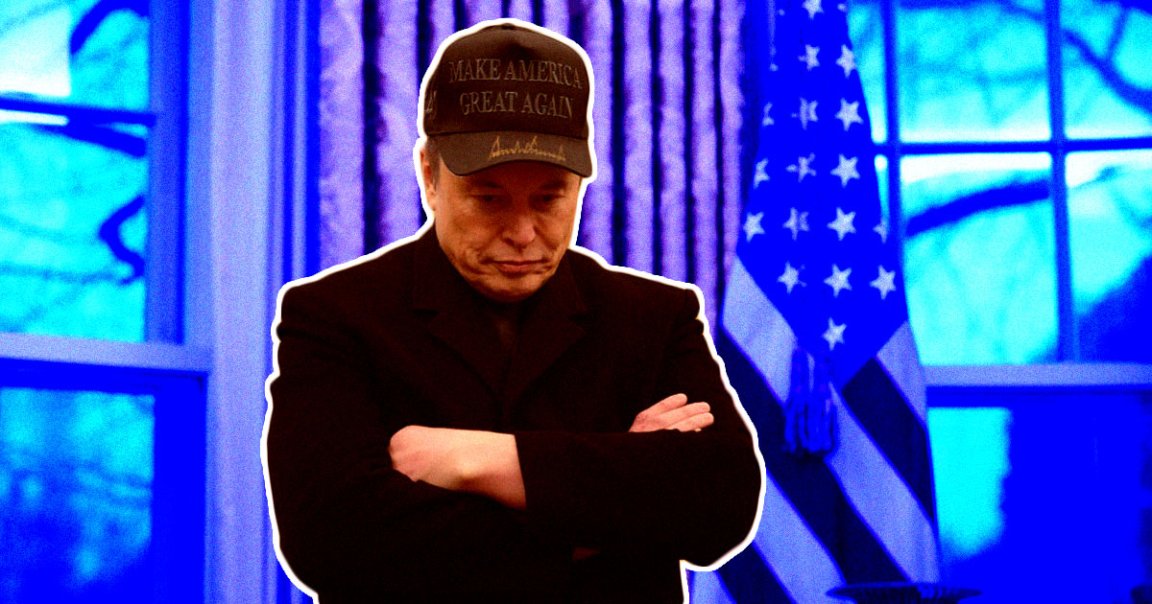
Tesla CEO Elon Musk’s plundering of the federal government has been incredibly bad for business.
The EV maker released its first-quarter earnings on Tuesday, reporting that its net income had cratered an astonishing 71 percent since the first quarter of last year. Total revenue is down nine percent, while sales have slid 13 percent between January and March compared to the same period last year.
The devastating numbers are in large part due to Musk’s personal behavior. He’s been criticized for greatly tarnishing the carmaker’s brand thanks to his extremist views and the catastrophic gutting of key government agencies with the assistance of his so-called Department of Government Efficiency.
His actions have spawned an international anti-Musk movement, with protesters targeting hundreds of Tesla dealerships.
The overwhelming negativity hasn’t flown over Musk’s head. With his carmaker going up in flames, the CEO desperately tried to justify his time away, while also admitting that he should be spending more of his time leading Tesla.
“As people know, there’s been some blowback for the time I’ve been spending in government with the Department of Government Efficiency,” Musk admitted during his opening statements on Tuesday’s earnings call.
Instead of owning up to his own actions, Musk continued to dig in his heels, arguing that the United States government was rife with “waste and fraud,” despite DOGE finding astonishingly little evidence so far.
During the call, the mercurial CEO argued that his gutting of the government was “critical work,” because “if the ship of America goes down, we all go down with it, including Tesla and everyone else.”
He also tried to paint protesters at Tesla dealerships — in a bizarre and unsubstantiated conspiracy theory — as being paid operatives who are somehow “receiving the waste and fraud” from the government.
However, Musk also made a market-shaking announcement: that his “time allocation to DOGE” will be reduced significantly, “starting probably next month.”
That’s what investors have been begging him to do. Tesla’s share price popped by more than eight percent on Wednesday, showing clear optimism for Musk’s return after a prolonged — and ruinous — absence.
“Musk needs to leave the government, take a major step back on DOGE, and get back to being CEO of Tesla full-time,” longtime Tesla bull and Wedbush Securities analyst Dan Ives argued in a Sunday note to clients. “Tesla is Musk and Musk is Tesla… and anyone that thinks the brand damage Musk has inflicted is not a real thing, spend some time speaking to car buyers in the US, Europe, and Asia.”
The carmaker seems to be painfully aware of its toxic CEO — as well as a rapidly changing political landscape, marked by president Donald Trump’s trade war.
In a letter to shareholders, Tesla said that Trump’s tariff war and “changing political sentiment could have a meaningful impact on demand for our products in the near-term.”
Musk also admitted that “tariffs are still tough on a company when margins are still low.”
“But we do have localized supply chains in North America, Europe, and China,” he added. “So that puts us in a stronger position than any of our competitors.”
However, Musk tried to actively distance himself from Trump, once his number one ally, arguing that the “decision is fundamentally up to” the president.
“So, you know, I’ll continue to advocate for lower tariffs rather than higher tariffs,” he argued, “but that’s all I can do.”
Musk also tried to blame the company’s abysmal Q1 numbers on the weather, arguing that the first quarter is “usually the worst quarter of the year, because people don’t want to go buy a car in the middle of winter during the blizzard.”
On Tuesday’s call, Musk made some characteristically ambitious promises about the carmaker’s timelines, claiming that “we expect to have thousands of Optimus robots working in Tesla factories by the end of this year” and that the company would be “selling fully autonomous rides in June in Austin.”
Whether either of those prognostics will turn out to be true remains unclear at best.
The company is still far from launching a Waymo-style, driverless taxi service. In November, Tesla applied for a transportation charter-party carrier permit (TCP), which is required to operate a ride-hailing service, as Reuters reported last month. However, the company still needs several other prerequisite permits to offer rides in fully autonomous vehicles.
We also don’t know how much progress Tesla has made on its “Cybercab” robotaxi. Musk is expected to provide an update later this year.
The CEO — who has never been known for his public speaking skills — appeared to have quite a bit of trouble formulating the company’s short-term vision during his opening remarks.
“I’d encourage people to look beyond like the, uh, some sort of bumps and potholes of the road immediately ahead of us,” he told investors. “But left your gaze to the bright shining sort of down on the hill, I don’t know, some Reagan-esque imagery.”
“And that’s where we’re headed and not too distant future,” he added. “Like I said, kind of next year or two. So, let’s see.”
The ball is now in Tesla’s court, and considering Musk’s extremely ambitious timelines, the company has its work cut out for it.
Tesla’s woes started well before Musk’s time in the White House, experiencing a “nightmare” 2024, marked by falling delivery numbers and failing to meet investors’ sky-high expectations.
But the situation is markedly different in 2025. For one, Tesla will have some far stickier problems to deal with this time around, from a greatly tarnished brand to a surge in international competition that’s starting to eat its lunch.
More on Tesla: Tesla’s Earnings Are Even More Brutal Than We Expected